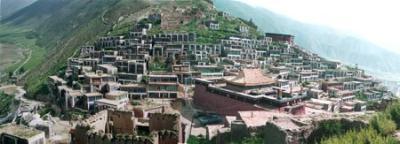
Kyegu Monastery India
Kamrao is a remote mountainous settlement; about 9 hours’ drive north of Delhi and was founded in 1965 by the Tibetan refugees who fled Tibet in 1958.
Through the many devotees of Buddhism and with the blessing of His Holiness the Dalai Lama and His Holiness Sakya Trizin, together with the continuous efforts and dedication of older monks from Tibet, Kamrao Kyegu Monastery was established.
At this formative period, the monks and lamas arriving from Tibet to live in the Monastery faced hardship due to climactic change and language difficulties. Kamrao Kyegu Monastery was established in order to revive the extraordinary Ga Kyegu Monastic tradition in the spreading of the noble Buddhadharma and devotion to the Sakya Tradition and its Teachers.
Non-Tibetan Dharma students such as Western students and Singaporean students have travelled to the Monastery to undertake retreats, receive instruction from His Eminence Aenpo Kyabgon Rinpoche, teach English to the younger monks and provide healthcare.
Therefore western students and South East Asian students share a strong connection with Kyegu Monastery in India. The Monastery had been partially rebuilt, housed approximately 600 monks until the devastating earthquake occurred right in Kyegu town on 14 April 2010.
The Shedra, Learning Institution, which was one of the biggest and most acclaimed colleges in Eastern Tibet where monk students study higher Buddhist philosophy, as well as the shrine room and living quarters were destroyed.
For more information on this devastation please go to www.kyegurelief.org

Kyegu Monastery Tibet
The Great Kyegu Monastery was first blessed by the great Dharma King Choegyal Phagpa (one of the five foremost founders of Sakya) in 1265, the year Choegyal Phagpa visited Kyegu town. Gyagarwa Sherab Gyaltsen (1436-1494) the 19th Throne holder of Sakya Hierarchy visited the Monastery, blessed it and named the Monastery "Dhondup Ling".
Later Khenchen Paldhen Choekyong (1702-1769), the 34th Abbot of Ngor School (a sub-sect of the Sakya Order) visited Kyegu Monastery and turned the wheel of Dharma there. Most of the grand halls of the Monastery were completely constructed at that time, namely Samdrup Gyatso (the main shrine hall), Maitreya Hall, the Immortal Hall, the Lecturing Courtyard etc.
The Monastery had approx 2000 monks before the Communist Chinese invasion in 1959. The Monastery had its own Shedra (college) where the studies of Buddhist philosophy were imparted to hundreds of students.Among the many who practised Buddhadharma and became learned scholars and great practitioners were: Lama Thinley Choephel, Lama Ngaga, Lama Riho, Tsejam and many others who were educated in the perfection and articulation of both rituals and tantric practices.
It was and still is the leading Monastery of the Sakya Tradition in Ga (Gawa), the area in Kham Province in Eastern Tibet.
Two other tulkus of the monastery are Megen Tulku and Gyanag Tulku.
Many of Rinpoche's students from Australia have enjoyed their visits to the monastery on several occasions prior to the earthquake and some students have visited the area few times after the devastating earthquake that hit the Kyegu town and the monastery was destroyed.
For more information on this devastation please go to